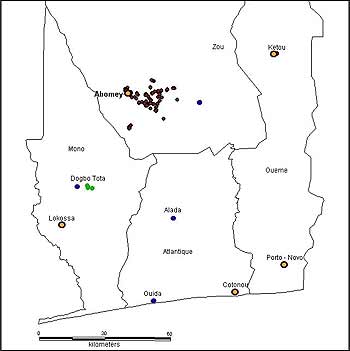BÉNIN
Projet benino-danois d'archéologie (BDArch)
In 1998 Danish road -constructors working near the old Dahomean capital of Abomey (nowadays Benin ) got a nasty surprise. One of their huge bulldozer suddenly disappeared in the ground .
This turned out to be the very beginning of an archaeological research initiative in Benin supported by the Danish Ministry of Foreign Affairs/Danida and involving Beninoise and Danish archaeologists.
The heavy machine had actually subsided into a huge man-made subterranean cave. Surveys reveal that such caves are indeed very common around Abomey, their number being in the thousands. See the area of research.
 |
|
Fig. 1. Inside a cave. Dug in laterite (iron-rich reddish clay), which tends to oxidize and harden, the caves are preserved in perfect state for centuries.
|
"If You do not know where You are going, at least You know where You came from"
(Beninoise saying)
Benin - once a French colony - became independent in 1960. However, as part of the territoire d'outre-mer it found itself lacking in basic institutions for studying it's past, establishing it's multi-cultural identity and preserve the country's cultural heritage. The Historical museum of Abomey founded in 1931 was the only cultural institution in the country for many years. Today there are seven public museums in Benin , but none of these has an archaeological post. The cultural heritage is under the jurisdiction of a heritage department under the Ministry of Culture - the Direction du Patrimoine Culturel. This is the only administrative institution that deals with archaeological issues of the country.
20 years ago an "Introduction to archaeology" course was for the first time given at the History Department of the National University of Benin. Nevertheless, the number of trained archaeologists is still too humble to tackle even basic archaeological research. The voice of archaeologists is seldom heard when bigger construction projects are set up or even when culturally significant monuments undergo restoration.
Therefore, the Danida-sponsored project was in much need. The Beninoise-Danish project underlines the need to develop rescue archaeology as an administrative branch and to establish archaeological research initiatives in an area where historical studies has been based on rich but limited story telling and European reports.

Fig. 2 Project coordinator civil engineer Annelise Boysen, The Royal Danish Embassy of Benin , is inspecting one of the caves.

Fig. 3. Administrative units and centres of Southern Benin (in orange). Distribution of cave sites (in red) and other archaeological localities (in blue), including iron production sites at Dogbo Tota (in green).
|